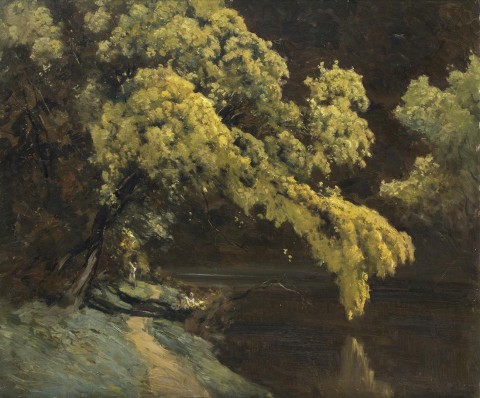WATTLE GATHERERS, 1918
PENLEIGH BOYD
oil on canvas
76.5 x 91.5 cm
signed and dated lower right: Penleigh Boyd / 18.
Fine Art Society, Melbourne
William Bertrand Carr, Melbourne, acquired from the above in 1918
Thence by descent
W.H. Carr, Melbourne, by 1965
Thence by descent
Private collection, Queensland
Exhibition of Paintings by Penleigh Boyd, Fine Art Society’s Galleries, Melbourne, 27 November – 11 December 1918, cat. 7
‘Exhibition of Pictures’, The Age, Melbourne, 27 November 1918, p. 8
‘Mr. Boyd’s Exhibition’, The Argus, Melbourne, 27 November 1918, p. 7
Colquhoun, A., ‘Australian Landscapes’, The Herald, Melbourne, 26 November 1918, p. 11
Wattle on the Yarra, c.1920, oil on canvas, 65.0 x 90.5 cm, in The Australian Landscape 1802-1975: a cultural exchange exhibition with China, Cultural Palace of the Nationalities, Peking, 2 – 17 September 1975; the Kiang Su Art Gallery, Nanking, 23 September – 7 October 1975; and the Art Gallery of New South Wales, Sydney, 14 – 30 November 1975
Penleigh Boyd’s exuberant paintings of wattle are among the highlights of early twentieth-century Australian art. Much admired for his lyrical views of Portsea on the Mornington Peninsula, Sydney Harbour and the Hawkesbury, Boyd’s most individual contributions are of golden wattles, especially those along the banks of the Yarra River at Warrandyte. An early example, Bridge and Wattle at Warrandyte, 1914, in the collection of the National Gallery of Australia, Canberra, presents wattle as part of the overall scene. By 1918 their cascades of gold become the subject itself, as seen in his exhibition at the Fine Art Society’s rooms in Melbourne. Enthusiastically received by the critics, his choice and skilled handling of wattle was commented on with some surprise. The Age noted: ‘… he tackles also with apparent ease that most incongenial [sic] of subjects to the majority of landscape painters, golden wattle in full bloom’.1 Alexander Colquhoun, art critic for The Herald, likewise acknowledged Boyd’s achievement:
Pictures of wattle in bloom are a feature of the exhibition, and in handling this elusive and delicate subject Mr Boyd has shown much skill and judgement, avoiding the sulphury suggestion so often given in such studies, and never losing sight of the individual characteristics of the tree.2
Our painting, Wattle Gatherers, 1918, was the highlight of the exhibition, singled out for comment by the three leading dailies. ‘There is much charm in the decorative “Wattle Gatherers,” with its wealth of massed blossom, and a river-refelected [sic] pendent plume’, reported The Argus.3 The Age was equally enthusiastic: ‘The canvas Wattle Gatherers depicts a shady bend of the river, with a shower of the blooms dipping its golden masses into the cool, clear stream’.4 With the discernment of an artist’s eye, Colquhoun observed: ‘Among the most attractive of these is Wattle Gatherers, one of the few canvases into which figures have been introduced, and one which is remarkable for the full and luminous treatment of the drooping masses of yellow blossom’.5 Paintings of wattle continued to feature in Boyd’s exhibitions and found ready admirers. In 1919 the National Gallery of Victoria acquired The Breath of Spring, 1919 through the Felton Bequest. In 1921 Boyd gave Spring Fantasy, 1919 to the Castlemaine Art Museum.
Wattle, the harbinger of spring, is a metaphor for the new in Boyd’s art. The inventive handling of form and mastery of colour introduced in Wattle Gatherers, heralded great promise. A second version, Wattle on the Yarra, c.1920, shows Boyd was well pleased with it.6 Unlike his conservative Australian contemporaries, Boyd was not ignorant of what was happening in Europe. Having studied in Paris in 1912, he was familiar with the French modernists. In 1922, he was in England selecting European contemporary art for the government-sponsored exhibition seen in Sydney and Melbourne in July-August of 1923.Wattle Gatherers, 1918 provides an exciting glimpse of what might have been achieved if his life had not been so tragically cut short in November of 1923.
1. ‘Exhibition of Pictures’, The Age, Melbourne, 27 November 1918, p. 8
2. Colquhoun, A., ‘Australian Landscapes’, The Herald, Melbourne, 26 November 1918, p. 11
3. ‘Mr. Boyd’s Exhibition’, The Argus, Melbourne, 27 November 1918, p. 7
4. The Age, op. cit.
5. Colquhoun, op. cit.
6. Wattle on the Yarra, c.1920 was given international prominence when shown in China in 1975 as part of the exhibition The Australian Landscape 1802-1975.
DAVID THOMAS
